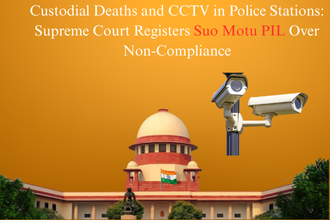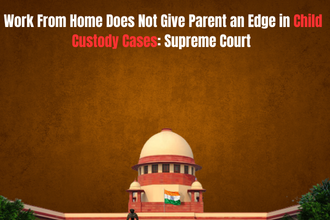Introduction
In a crucial step to protect human rights and accountability in law enforcement, the Supreme Court of India has registered a suo motu public interest litigation (PIL) highlighting the alarming issue of non-functional CCTV cameras in police stations across the country. The case was initiated on September 4, 2025, by a Bench of Justices Vikram Nath and Sandeep Mehta, after a Dainik Bhaskar report revealed that 11 custodial deaths had taken place in the last 7–8 months.
This development underscores the judiciary’s proactive role in ensuring that its earlier landmark judgment mandating CCTV surveillance in police stations and investigative agency offices is properly implemented. The suo motu case has the potential to strengthen police accountability, human rights protection, and transparency in custodial practices.
Background: Custodial Deaths and Supreme Court’s 2020 Directions
The 2020 Landmark Judgment
In Paramvir Singh Saini v. Baljit Singh & Ors. (2020), a three-judge Bench of Justice Rohinton Fali Nariman, Justice KM Joseph, and Justice Aniruddha Bose directed:
- Mandatory installation of CCTV cameras with night vision in all police stations across States and Union Territories.
- Extension of CCTV surveillance to investigative agencies such as the CBI, NIA, ED, NCB, DRI, SFIO, and other central offices where interrogation is conducted.
- Ensuring that CCTV systems are equipped with both audio and video recording facilities.
- Obligation on States/UTs to provide electricity and internet to enable functioning of cameras, including through solar or wind power in remote areas.
The Court also ruled that in cases of custodial torture or custodial deaths, complaints could be filed before Human Rights Courts, which would then summon the CCTV footage for preservation and evidence. Victims of human rights violations were entitled to obtain such footage.
Persistent Non-Compliance
Despite these categorical directions, reports from across India reveal that:
- Many police stations either lack CCTVs entirely or have defunct systems.
- Authorities often claim “missing footage” when asked to produce recordings.
- Families of victims in custodial death cases are left without crucial evidence.
This gap between judicial directions and ground-level enforcement has contributed to impunity in cases of custodial torture and deaths.
Supreme Court’s Suo Motu Action in 2025
The trigger for the suo motu PIL was a Dainik Bhaskar report documenting 11 custodial deaths in just 7–8 months of 2025.
The Bench of Justices Vikram Nath and Sandeep Mehta observed:
“Based on Dainik Bhaskar, we are directing for a suo motu public interest litigation titled ‘lack of functional CCTVs in police stations’, as it has been reported that there are 11 death in last 7–8 month in year 2025 in police custody.”
By taking suo motu cognizance, the Court has signaled its concern over the persistent failure of police authorities to comply with its binding directions and the serious consequences of this neglect on citizens’ fundamental rights under Article 21 (Right to Life and Personal Liberty).
Why CCTV in Police Stations is Crucial
- Prevention of Custodial Torture
- Functional CCTV cameras act as a deterrent against custodial violence, ensuring that interrogations and detentions are conducted lawfully.
- Evidence in Custodial Death Cases
- CCTV footage provides objective evidence in allegations of police brutality, thereby preventing cover-ups and fabricated reports.
- Strengthening Public Trust
- Citizens are more likely to trust law enforcement when there is a mechanism of independent oversight and transparency.
- Compliance with Human Rights Norms
- India is a signatory to the International Covenant on Civil and Political Rights (ICCPR), which prohibits torture. CCTV surveillance strengthens compliance with international obligations.
Legal and Constitutional Dimensions
Article 21 – Right to Life and Dignity
Custodial deaths directly violate Article 21, which guarantees protection of life and personal liberty. CCTV installation is a procedural safeguard to uphold this right.
Article 14 – Equality Before Law
Citizens, regardless of their socio-economic status, deserve protection against state excesses. Non-functional CCTVs disproportionately affect marginalized groups who are more vulnerable to police misconduct.
Precedents on Custodial Deaths
- D.K. Basu v. State of West Bengal (1997): Laid down detailed guidelines against custodial torture, including arrest procedures and medical examinations.
- Nilabati Behera v. State of Orissa (1993): Recognized the principle of compensation for custodial deaths as a public law remedy.
- Re-Inhuman Conditions in 1382 Prisons (2016): Emphasized the need for prison reforms and mechanisms against custodial violence.
The present suo motu case continues this jurisprudential trajectory of human rights protection.
Challenges in Implementation
While the Court’s directions are clear, several practical hurdles remain:
- Budgetary Constraints: Many States cite lack of funds to procure advanced CCTV systems.
- Maintenance Issues: Installed systems often fall into disrepair without proper upkeep.
- Accountability Gaps: No clear mechanism exists to hold officials liable for non-functional cameras.
- Data Storage and Access: Questions remain on who maintains footage, for how long, and how victims can securely access it.
Unless these systemic challenges are addressed, mere judicial directions may not translate into effective change.
The Way Forward
To ensure that the 2020 directions and the new suo motu PIL achieve their intended effect, the following measures are essential:
- Strict Compliance Monitoring
- Supreme Court and High Courts must periodically demand compliance reports from States and Union Territories.
- Budget Allocation
- Central and State governments must earmark dedicated funds for installation and maintenance of CCTVs.
- Independent Oversight Committees
- Human Rights Commissions should be empowered to conduct random inspections and audits of CCTV functionality.
- Penalties for Non-Compliance
- Police officials who fail to maintain functional CCTVs should face disciplinary and legal consequences.
- Technological Integration
- Cloud-based storage, AI-enabled monitoring, and solar-powered systems can resolve issues of data loss and power supply.
- Awareness and Training
- Police personnel should be sensitized about the importance of CCTV compliance as a constitutional duty.
Conclusion
The Supreme Court’s suo motu intervention on custodial deaths and non-functional CCTVs marks a renewed push for police accountability and human rights protection in India. By revisiting its 2020 directions, the Court has reminded authorities that compliance is not optional but a constitutional necessity under Article 21.
At a time when custodial deaths continue to scar India’s justice system, functional CCTV cameras in police stations are not just a matter of technology but a safeguard for democracy, dignity, and rule of law. The success of this suo motu case will depend on whether governments and police authorities finally rise to the occasion and enforce accountability at every level.
Also Read
NEET-UG 2025: Supreme Court Dismisses Plea Alleging OMR Sheet Tampering



